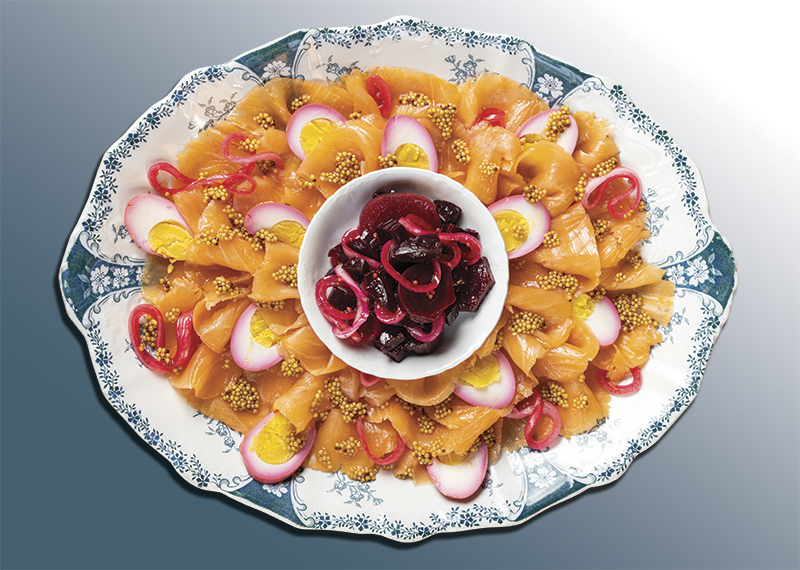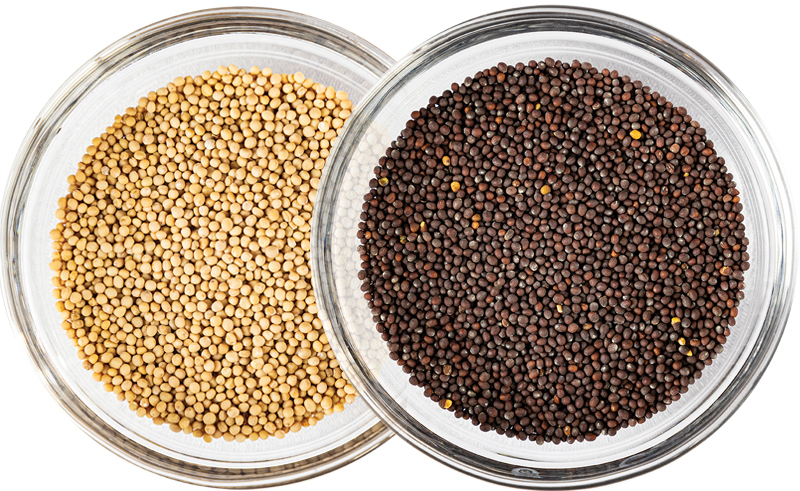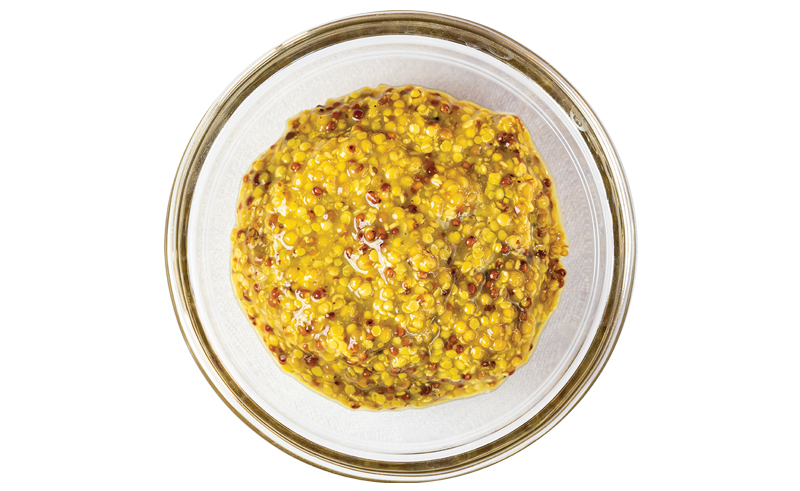
During the holiday season, it’s comforting to be prepared for surprise visitors or unexpected invitations by having a beautiful and tasty dish you can quickly and easily assemble. Pickled foods fit the bill in this situation, and pickled beets, eggs, and mustard seeds garnishing a platter of cured or smoked salmon is sure to please just about everyone.
First, let’s talk about cured salmon. The reason we love it (either cured or cold smoked), is that because the fish has not been exposed to heat, all of its fat is still intact—anyone who has ever grilled a piece of salmon knows how much fat typically comes out when it cooks. Because flavor molecules travel on fat molecules, uncooked salmon tastes delicious (and that explains why we love fatty foods in general). Smoked salmon can be either cold or hot-smoked. Hot-smoked salmon has been smoked at a high enough temperature that it actually cooks—you can tell by the pale, cooked color, and you will see white congealed protein (albumin) around the edges. Cold-smoked salmon is cured first, then smoked at a low temperature.
Lox is another name for brine-cured salmon, and you find it both smoked and not. When buying cured salmon, in most cases you get what you pay for. If it seems especially cheap, it is probably not of the best quality. For those so inclined, it is quite simple to cure salmon at home and gives you something to do with that whole side of salmon you bought at Costco but don’t want to cook all at once.*
As for pickled garnishes for the salmon, one of my favorite companions to the luscious fish is pickled mustard seed (mustard in any form, really)—but other pickled foods play equally well. Eggs and onions are a traditional companion to cured salmon, so why not pickle those, too? Beets for festive color—why not? The quick pickle technique below works on many foods, especially if they are cut into smaller pieces. Whether you cure your own salmon and pickle your mustard, beets, and eggs, or buy good quality smoked salmon, some gherkins and gourmet mustard, with this flavorful combination of pickles and fish, you’ll be ready for any festive occasion this season.
Salmon with Pickled Beets, Eggs, and Mustard Seeds
Begin by roasting a few beets (this can take anywhere from 45 minutes to an hour and a half depending on the size of the beets: wash beets, wrap in a piece of foil and roast in a 400F oven until tender enough to pierce with a fork). While they roast, pickle the mustard seeds. In a small saucepan, combine one half cup mustard seeds (yellow, brown, or mixed, see Pantry), one cup water, one cup white vinegar (or white wine, rice, or apple cider vinegar—the tastier the better), one quarter cup sugar and a heaping teaspoon of salt. Bring everything to a simmer and cook for about 30 minutes, until the consistency is thick and syrupy and when you taste a few seeds, they are resistant but tender and “pop” between the teeth, much like caviar. Think about the taste—if you would like it to be sweeter, add a bit more sugar, or more vinegar, salt, etc.
While the beets and seeds are cooking, prepare the hard-boiled eggs by placing a few eggs in a pot covered by one inch of water, and bring them to a boil. As soon as they come to a boil, turn off the heat and let them sit for exactly ten minutes. Check in on the mustard seeds every now and again to make sure they don’t dry out and scorch. After ten minutes, immediately rinse the eggs and peel them. You should have perfectly hard-boiled eggs with no trace of green ring around the yolk and whites that are tender. Next, make the pickling solution for the eggs and beets. My favorite brine is what I think of as my “bread and butter” profile, tangy but with a generous hint of sweetness to balance the spice, which I tweak according to the situation. First, thinly slice half an onion, lightly salt it, and set it aside. In saucepan, combine one cup water, 2 cups apple cider (or other good) vinegar, one teaspoon of salt, one heaping tablespoon of mustard seed, two allspice berries, one teaspoon black peppercorns, 2 cloves of garlic and a big pinch of crushed red pepper flakes. Bring all of this to a boil and simmer for ten minutes. Remove from the heat and allow it to cool. When the beets are tender, slice or dice them, then combine with the cooled brine, the sliced onion (now wilted and a little salty), and the eggs. The hard part is now over. For the best looking and tasting eggs, allow them to sit in the brine with the beets for at least 24 hours. They will have a pretty pink tinge around the edges and still be tender. Over time, they will take on a deeper color, but the whites could firm up and become rubbery (although some people like that). Otherwise, everything can sit in the brine for a week or two and still be fine.
To serve, arrange sliced cured or smoked salmon on a platter garnished with the sliced eggs, beets, onion, and tiny dollops of the pickled mustard seeds. This presentation is really just a springboard for a platter of cured salmon. Fennel fronds or other fresh elements like piquant greens (watercress, frisée, arugula, and Belgian endive leaves), radish, chives, or capers are all welcome substitutions or additions to this platter. Remember, the exciting aspect of pickling is the little element of surprise when you taste the finished product. With experience, you’ll learn to recreate the flavors you like best so that you can share them at your next special get together.
*For home-cured salmon, take equal parts salt and sugar, combine them, and thoroughly coat a piece of salmon on all sides, wrap it tightly in plastic, put it in the fridge, and put a weight on it. It will cure in a day or two and be ready to eat. Just rinse off the cure and thinly slice. It will easily keep for a week or more. Additional flavor in the form of citrus zest, basil leaves, fennel fronds or even anise liqueur can be added to the sugar/salt mixture. Google for more details and techniques.
In Your Pantry
Mustards
There are many ways to introduce the sinus-opening, palate-refreshing punch of mustard. Indian mango pickles, Italian mostarda (candied mustard-preserved fruit), horseradish, and wasabi are some of the more exotic, but the effects come from the same chemical building blocks. Despite the thousands of years mustard seeds have been used by humans as food and medicine, the technique for using these pungent grains has remained remarkably unchanged: mustard seeds are ground or crushed and mixed with liquid which converts to mustard oil. The intensity of mustard seeds is distinguishable visually—the darker the seed the more intense the flavor. Here are some mustard basics:

White/Yellow/Brown/Black Mustard Seeds
Yellow (sometimes called white) seeds are the most common, especially in Western cultures. The brown and especially the black are more intense. In addition to the color of the seeds, the amount of acidity in the liquid used to make the mustard also affects the strength and duration of the heat of the finished product. Water makes much stronger mustard than vinegar. Once the seeds are ground and combined with liquid, the mustard’s intensity will soon begin to fade, unless stabilized by something acidic like vinegar.

Dijon Mustard
Although not necessarily made in Dijon, France, today, the formulation of mustard standardized by Frenchman Jean Naigeon in 1865 has become a culinary staple. Brown mustard seed is mixed with a less acidic liquid (originally verjus, the acidic juice from immature grapes) giving it a pungency and heat that translate well when used in cooking, lending its mustardy flavor to countless dishes. It’s also great on a hot dog if you’re looking for a little more kick than that of yellow ballpark mustard.

Whole Grain or Coarse Mustard
The textural component of grainy mustard is perhaps its greatest asset. In this style of mustard, the seeds are only lightly crushed (just enough to make a paste), and any color of seed or liquid may be used, so the heat and intensity can vary greatly from brand to brand. Great for sandwiches, served with cheeses, and making an outstanding honey-mustard dressing or dip.


